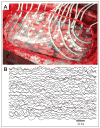Epilepsy as a disorder of cortical network organization
- PMID: 22235060
- PMCID: PMC3736575
- DOI: 10.1177/1073858411422754
Epilepsy as a disorder of cortical network organization
Abstract
The brain is naturally considered as a network of interacting elements which, when functioning properly, produces an enormous range of dynamic, adaptable behavior. However, when elements of this network fail, pathological changes ensue, including epilepsy, one of the most common brain disorders. This review examines some aspects of cortical network organization that distinguish epileptic cortex from normal brain as well as the dynamics of network activity before and during seizures, focusing primarily on focal seizures. The review is organized around four phases of the seizure: the interictal period, onset, propagation, and termination. For each phase, the authors discuss the most common rhythmic characteristics of macroscopic brain voltage activity and outline the observed functional network features. Although the characteristics of functional networks that support the epileptic seizure remain an area of active research, the prevailing trends point to a complex set of network dynamics between, before, and during seizures.
Conflict of interest statement
The author(s) declared no potential conflicts of interest with respect to the research, authorship, and/or publication of this article.
Figures






References
-
- Alarcon G, Binnie CD, Elwes RD, Polkey CE. Power spectrum and intracranial EEG patterns at seizure onset in partial epilepsy. Electroencephalogr Clin Neurophysiol. 1995;94(5):326–37. - PubMed
-
- Altenburg J, Vermeulen RJ, Strijers RLM, Fetter WPF, Stam CJ. Seizure detection in the neonatal EEG with synchronization likelihood. Clin Neurophysiol. 2003;114(1):50–5. - PubMed
-
- Antiqueira L, Rodrigues FA, van Wijk BCM, da F Costa L, Daffertshofer A. Estimating complex cortical networks via surface recordings—a critical note. Neuroimage. 2010;53(2):439–49. - PubMed
-
- Arnhold J, Grassberger P, Lehnertz K, Elger C. A robust method for detecting interdependences: application to intracranially recorded EEG. Physica D. 1999;134(4):419–30.
Publication types
MeSH terms
Grants and funding
LinkOut - more resources
Full Text Sources
Medical

